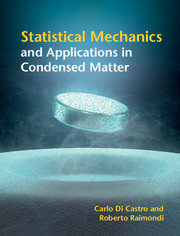Book contents
- Frontmatter
- Contents
- Preface
- 1 Thermodynamics: a brief overview
- 2 Kinetics
- 3 From Boltzmann to Boltzmann–Gibbs
- 4 More ensembles
- 5 The thermodynamic limit and its thermodynamic stability
- 6 Density matrix and quantum statistical mechanics
- 7 The quantum gases
- 8 Mean-field theories and critical phenomena
- 9 Second quantization and the Hartree–Fock approximation
- 10 Linear response and the fluctuation–dissipation theorem in quantum systems: equilibrium and small deviations
- 11 Brownian motion and transport in disordered systems
- 12 Fermi liquids
- 13 The Landau theory of second order phase transitions
- 14 The Landau–Wilson model for critical phenomena
- 15 Superfluidity and superconductivity
- 16 Scaling theory
- 17 The renormalization group approach
- 18 Thermal Green functions
- 19 The microscopic foundations of Fermi liquids
- 20 The Luttinger liquid
- 21 Quantum interference effects in disordered electron systems
- Appendix A The central limit theorem
- Appendix B Some useful properties of the Euler Gamma function
- Appendix C Proof of the second theorem of Yang and Lee
- Appendix D The most probable distribution for the quantum gases
- Appendix E Fermi–Dirac and Bose–Einstein integrals
- Appendix F The Fermi gas in a uniform magnetic field: Landau diamagnetism
- Appendix G Ising and gas-lattice models
- Appendix H Sum over discrete Matsubara frequencies
- Appendix I Two-fluid hydrodynamics: a few hints
- Appendix J The Cooper problem in the theory of superconductivity
- Appendix K Superconductive fluctuation phenomena
- Appendix L Diagrammatic aspects of the exact solution of the Tomonaga–Luttinger model
- Appendix M Details on the theory of the disordered Fermi liquid
- Appendix N Answers to problems
- References
- Index
2 - Kinetics
Published online by Cambridge University Press: 05 September 2015
- Frontmatter
- Contents
- Preface
- 1 Thermodynamics: a brief overview
- 2 Kinetics
- 3 From Boltzmann to Boltzmann–Gibbs
- 4 More ensembles
- 5 The thermodynamic limit and its thermodynamic stability
- 6 Density matrix and quantum statistical mechanics
- 7 The quantum gases
- 8 Mean-field theories and critical phenomena
- 9 Second quantization and the Hartree–Fock approximation
- 10 Linear response and the fluctuation–dissipation theorem in quantum systems: equilibrium and small deviations
- 11 Brownian motion and transport in disordered systems
- 12 Fermi liquids
- 13 The Landau theory of second order phase transitions
- 14 The Landau–Wilson model for critical phenomena
- 15 Superfluidity and superconductivity
- 16 Scaling theory
- 17 The renormalization group approach
- 18 Thermal Green functions
- 19 The microscopic foundations of Fermi liquids
- 20 The Luttinger liquid
- 21 Quantum interference effects in disordered electron systems
- Appendix A The central limit theorem
- Appendix B Some useful properties of the Euler Gamma function
- Appendix C Proof of the second theorem of Yang and Lee
- Appendix D The most probable distribution for the quantum gases
- Appendix E Fermi–Dirac and Bose–Einstein integrals
- Appendix F The Fermi gas in a uniform magnetic field: Landau diamagnetism
- Appendix G Ising and gas-lattice models
- Appendix H Sum over discrete Matsubara frequencies
- Appendix I Two-fluid hydrodynamics: a few hints
- Appendix J The Cooper problem in the theory of superconductivity
- Appendix K Superconductive fluctuation phenomena
- Appendix L Diagrammatic aspects of the exact solution of the Tomonaga–Luttinger model
- Appendix M Details on the theory of the disordered Fermi liquid
- Appendix N Answers to problems
- References
- Index
Summary
According to the second law of thermodynamics, the evolution towards an equilibrium state corresponds to the increase of the entropy of a thermally isolated system, or, depending on the external conditions, by the decrease of an appropriate thermodynamic potential. Statistical mechanics must explain the origin of such a law starting from the laws which control the motion of the microscopic constituents of matter. At a microscopic level, however, all the basic laws are symmetric with respect to time reversal. This suggests that a purely mechanical derivation of the second law of thermodynamics is conceptually impossible and a more subtle reasoning, based on probability considerations, is necessary to explain irreversibility and the thermodynamics of a system in terms of the motion of its elementary constituents. This has been clearly explained by Boltzmann after several years of intense thinking. Towards the end of his life, Boltzmann published (in 1896) Lectures on Gas Theory (Boltzmann (1964)). This is the topic of this chapter and the next.
The birth of kinetic theory
Kinetic theory makes its first appearance in the book Hydrodynamics published by Daniel Bernoulli in 1738 (Bernoulli and Bernoulli (2005)). The assessment of the kinetic approach of Bernoulli was undertaken by Clausius (1857). Bernoulli's argument explains the pressure exercised by a gas on the walls of the container in terms of the collisions of its constituent molecules. Let us imagine a molecule approaching one of the walls of the gas container as shown in Fig. 2.1. We assume elastic scattering and the wall perpendicular to the x-axis. Let vx 0 be the component along the x-axis of the initial velocity. Since upon bouncing on thewall the molecule reverses the sign of its perpendicular velocity component, the transferred momentum to the wall is 2mvx, m being the mass of the molecule. The transferred momentum per unit time is the force exercised by the molecule on the wall during a single collision. The total force on the wall is the cumulative effect of the collisions occurring in unit time. The number of collisions is the number of molecules which during the unit time, dt, will collide with the wall, i.e. those which are vxdt far away from the wall.
- Type
- Chapter
- Information
- Publisher: Cambridge University PressPrint publication year: 2015



